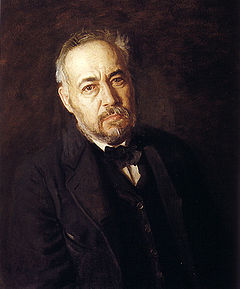
Self-portrait (Thomas Eakins)
Encyclopedia

Thomas Eakins
Thomas Cowperthwait Eakins was an American realist painter, photographer, sculptor, and fine arts educator...
, presented as a diploma piece upon his election as an Associate member of the National Academy of Design
National Academy of Design
The National Academy Museum and School of Fine Arts, founded in New York City as the National Academy of Design – known simply as the "National Academy" – is an honorary association of American artists founded in 1825 by Samuel F. B. Morse, Asher B. Durand, Thomas Cole, Martin E...
in 1902. Although Eakins included himself as an observer or participant in group portraits and genre scenes, this and a smaller unsigned and undated oil, thought to have been made at about the same time, are the only unadorned self-portraits he ever painted. Lloyd Goodrich
Lloyd Goodrich
Lloyd Goodrich was an influential American art historian. He wrote extensively on American artists, including Edward Hopper, Thomas Eakins, Winslow Homer, Raphael Soyer and Reginald Marsh...
wrote that it "is not only one of his finest head and bust likenesses, but a revealing human document; in the direct look of his remarkable eyes one can see strength, penetrating intelligence, and a touch of ironic humor."
Background
Largely due to controversies surrounding his work, Eakins was not invited to become a member of the National Academy of Design until 1902, well after many of his contemporaries. It was only in the late 1890s that his reputation benefited from a positive reassessment by his colleagues, as well as a rediscovery by a younger generation of artists and writers. Unanimously approved as an Associate-elect of the National Academy on 12 March 1902, Eakins quickly painted this self-portrait and submitted it to the Academy on 5 May, and was accepted as a full Academician at the annual meeting on 14 May; he remains the only artist in the Academy's history to be made an Associate and full Academician in the same year.Previously Eakins had included himself in several early sporting pictures, as well as The Swimming Hole
The Swimming Hole
The Swimming Hole is an 1884–85 painting by the American artist Thomas Eakins , Goodrich catalog #190, in the collection of the Amon Carter Museum in Fort Worth, Texas. Executed in oil on canvas, it depicts six men swimming naked in a lake, and is considered a masterpiece of American painting...
, and in his large group portraits The Agnew Clinic
The Agnew Clinic
The Agnew Clinic, or, The Clinic of Dr. Agnew, is an 1889 oil painting by American artist Thomas Eakins, Goodrich #235. It was commissioned to honor anatomist and surgeon David Hayes Agnew, on his retirement from teaching at the University of Pennsylvania.-Background:The Agnew Clinic depicts Dr....
and The Gross Clinic
The Gross Clinic
The Gross Clinic, or, The Clinic of Dr. Gross, is an 1875 painting by American artist Thomas Eakins. It is oil on canvas and measures by . Dr. Samuel D. Gross, a seventy-year-old professor dressed in a black frock coat, lectures a group of Jefferson Medical College students...
, and later he would paint himself in side view for William Rush and His Model
William Rush and His Model
William Rush and His Model is the name given to several paintings by Thomas Eakins, one set from 1876-77 and the other from 1908. These works depict the American wood sculptor William Rush in 1808, carving his statue Water Nymph and Bittern for a fountain at Philadelphia's first waterworks...
. However, the two paintings of 1902 were his only independent self-portraits.

Painting
At 30 by 25 in (76.2 by 63.5 ), the Academy canvas is larger than Eakins' customary format of 24 by 20 in (61 by 50.8 ) for a bust portrait. He is seen in formal attire, wearing a dark suit with buttoned waistcoat, white shirt and a dark tie. His hair is unkempt and his mustache unevenly trimmed; the contrast between clothing and grooming alludes to a rebellious nature restrained by cultural mores. Compared to the smaller portrait, there is a greater sense of space and less intense physical immediacy— for John UpdikeJohn Updike
John Hoyer Updike was an American novelist, poet, short story writer, art critic, and literary critic....
, the National Academy picture "tames down a more truculent and even satanic earlier version"— though in both paintings Eakins makes direct eye contact with the viewer, a motive he very rarely used except for subjects with whom he was most familiar. Rarer still is such emphasis on the eye's liquid reflection, which accents the emotional impact of the image. The pose of the upper body is the same as that which Eakins used in Portrait of Leslie W. Miller
Portrait of Leslie W. Miller
Portrait of Leslie W. Miller is a 1901 painting by Thomas Eakins, Goodrich #348. It is in the permanent collection of the Philadelphia Museum of Art.-The sitter:...
, painted in 1901.
The painting is a fine example of Eakins' mature technique— "an unmatched demonstration of his absolute control of the medium"— and a powerful psychological study. Flesh and bone structure are painted with small strokes of fluid paint that offer a successful illusion of light-struck form, and at the same time the artist's self-depiction suggests emotional vulnerability. While presenting an expression that has been interpreted as one of "accusation and bitterness", art historian Darrel Sewell has noted that the painting's power resides in its emotional ambiguity, and that it bears closer relationship to the sympathetic intimacy of Eakins' portraits of women than to his more psychologically distant images of men.

